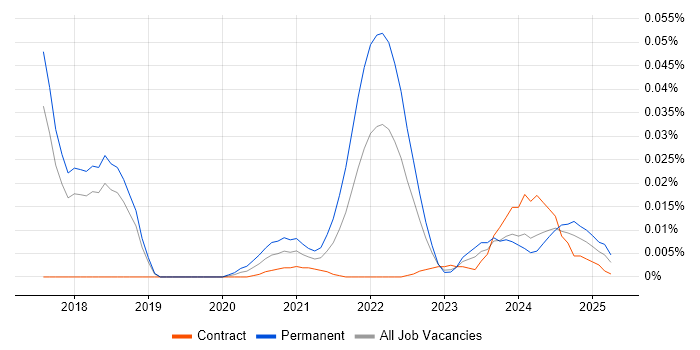Software Optimisation
UK > Work from Home
The table below provides summary statistics and contractor rates for remote or hybrid contract work requiring Software Optimisation skills. It covers contract job vacancies from the 6 months leading up to 25 November 2025, with comparisons to the same periods in the previous two years.
| 6 months to 25 Nov 2025 |
Same period 2024 | Same period 2023 | |
|---|---|---|---|
| Rank | - | 326 | - |
| Rank change year-on-year | - | - | - |
| Contract jobs citing Software Optimisation | 0 | 1 | 0 |
| As % of all contract jobs with remote/hybrid work options | - | 0.008% | - |
| As % of the Processes & Methodologies category | - | 0.009% | - |
| Number of daily rates quoted | 0 | 1 | 0 |
| Median daily rate (50th Percentile) | - | £425 | - |
| UK median daily rate | - | £425 | £575 |
| % change year-on-year | - | -26.09% | - |
All Process and Methodology Skills
Work from Home
Software Optimisation falls under the Processes and Methodologies category. For comparison with the information above, the following table provides summary statistics for all contract job vacancies with remote or hybrid options requiring process or methodology skills.
| Contract vacancies with a requirement for process or methodology skills | 9,389 | 10,732 | 16,044 |
| As % of all contract jobs with a WFH option | 91.56% | 88.19% | 88.73% |
| Number of daily rates quoted | 6,208 | 6,740 | 11,077 |
| 10th Percentile | £325 | £325 | £338 |
| 25th Percentile | £413 | £413 | £425 |
| Median daily rate (50th Percentile) | £513 | £525 | £525 |
| Median % change year-on-year | -2.38% | - | -4.55% |
| 75th Percentile | £625 | £638 | £640 |
| 90th Percentile | £725 | £750 | £740 |
| UK median daily rate | £500 | £525 | £533 |
| % change year-on-year | -4.76% | -1.41% | -3.18% |
| Number of hourly rates quoted | 340 | 217 | 384 |
| 10th Percentile | £15.18 | £17.96 | £19.99 |
| 25th Percentile | £20.50 | £22.50 | £26.25 |
| Median hourly rate | £41.25 | £37.50 | £52.50 |
| Median % change year-on-year | +10.00% | -28.57% | -2.78% |
| 75th Percentile | £65.00 | £65.00 | £70.00 |
| 90th Percentile | £70.00 | £75.00 | £86.50 |
| UK median hourly rate | £25.15 | £35.00 | £44.50 |
| % change year-on-year | -28.14% | -21.35% | +27.14% |
Software Optimisation
Job Vacancy Trend for Remote/Hybrid Jobs
Historical trend showing the proportion of contract IT job postings citing Software Optimisation and offering remote or hybrid work options relative to all contract IT jobs advertised.

